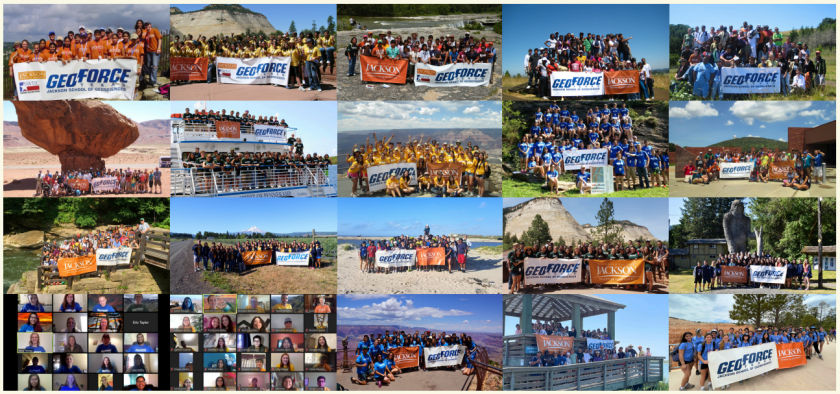20 Years of GeoFORCE
January 16, 2025
Twenty years ago, the dean of the Jackson School of Geosciences at the University of Texas tasked Doug Ratcliff, a former Bureau Associate Director, with establishing a youth geoscience program.
Earth science is not a required field in Texas high schools, especially in areas that have limited staffing to teach electives. Though geoscience jobs have boomed over the last twenty years—and continue to grow, it has one of the lowest populations of students of any STEM field.
GeoFORCE was developed to recruit students from areas that didn’t have access to Earth science. Ratcliff landed on the Southwest region of Texas through a connection with the dean of Southwest Texas Junior College in Uvalde. Most schools in the surrounding towns are Title I, meaning they have little access to any college-prep resources.
“The teachers and principals and parents were incredibly helpful. And I mean, it was a huge deal for some of those families to let their kids go on those trips. More than once, I had a mother tell me I had to talk to the father because he wasn’t going to let their kid go. Ultimately, they did. And once they got in, they realized what a benefit it was to their kids.” said Ratcliff.
Word got around of the program, and before long, application numbers spiked. Because the capacity for the GeoFORCE Academies was 44 students, Ratcliff created the Young Geos, which took students on shorter field trips around Texas.
Out of the many youth programs run by the University of Texas at Austin, GeoFORCE is one of two programs allowed to take students on overnight trips out of Texas.
“It took some convincing. We jumped some big hurdles with UT lawyers,” said Ratcliff, “but I think our record speaks for itself”.
Academy destinations were chosen by Ratcliff and his colleague Jay Raney, of the Bureau of Economic Geology. The intention was to take students to spectacular places to really make an impact. To measure impact, they created the guidebook, came up with ways to challenge students academically, and picked field locations with the “wow” factor.
In 2008, the GeoFORCE Program expanded into Houston with the influence of sponsoring companies. In 2020, GeoFORCE began recruiting for an Austin cohort. Now, the GeoFORCE impact has spread to other areas of Texas, with students from Midland, Brownsville, and Dallas. To better acknowledge the breadth of students, the newest 9th grade cohorts will be split into GeoFORCE East and GeoFORCE West groups.

In the last 20 years, GeoFORCE has made some pretty significant accomplishments. 1,837 high school students have gone through the program. The high school graduation rate for GeoFORCE students is 100%. According to the National Student Clearinghouse Database which students can elect to be included in, 837 students have obtained a bachelor’s degree. 354 have obtained a bachelor’s degree in the STEM field, and 96 have obtained a degree in the field of geoscience. 129 master’s degrees have been awarded, and 19 Ph.D.’s. While a majority of students choose to pursue a degree in Texas, GeoFORCE students have gone on to attend universities across the country and abroad.
According to the National Center for Education Statistics, when the program began the percentage of Texas adults 25 and older with a college degree was 25.1%. As of last year, the percentage was 33.1%. Programs like GeoFORCE are an imperative resource to so many students who otherwise may not attend college. In fact, one out of every three GeoFORCE students is a first-generation college student. The GeoFORCE program aims to transform the lives of its students. Not only by showing them career options in geosciences, but by taking them to beautiful geologic wonders, matching students with internships and scholarships, and creating a lifelong community.
When asked if he had a favorite cohort or memory, Ratcliff answered “One of the best was the first group that went through. They were very flexible, and they all stuck with [GeoFORCE]. Doctors and all sorts of stuff came out of that group.”
Last month, the Jackson School of Geosciences Communications Team put out a fantastic article highlighting five members of the very first GeoFORCE cohort. Featured is Carlos De La Torre, a U.S. Forest Service Partnership Coordinator, Debbie Duran, PG, a senior consultant at Booz Allen Hamilton, Felipe Villanueva, a Chemical Safety Specialist at UTSA, Isaac Jiminez, an Environmental Specialist, and Marissa Vara, a Higher Education Specialist. You can find a link to that article here.
We look forward to continuing serving the students of Texas, continuing to find opportunities, and inspiring the next generation of geoscientists. We would like to thank you all for 20 incredible years. Here’s to 20 more!



